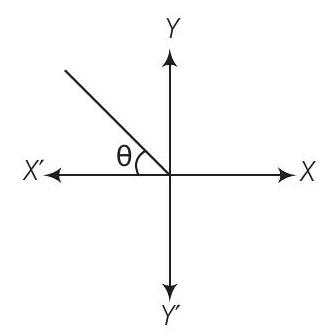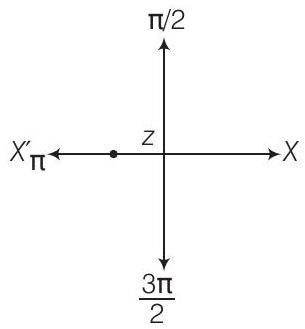Complex Numbers and Quadratic Equations
Short Answer Type Questions
1. For a positive integer
Show Answer
Solution
Given expression
2. Evaluate
Thinking Process
Show Answer
Solution
Given that,
Alternate Method
3. If
Thinking Process
If two complex numbers
Show Answer
Solution
Given that,
Similarly,
Using Eqs. (ii) and (iii) in Eq. (i), we get
On comparing real and imaginary part of complex number, we get
So,
4. If
Show Answer
Solution
Given that,
On comparing both sides, we get
5. If
Show Answer
Solution
Given that,
6. If
Thinking Process
To solve the above problem use the trigonometric formula
Show Answer
Solution
Given that,
7. If
Show Answer
Solution
We have,
Hence proved.
8. If
Show Answer
Solution
Given that,
Then,
Now,
9. If the real part of
Show Answer
Solution
Taking real part,
Hence,
10. Show that the complex number
Thinking Process
First use,
and then use the property
Show Answer
Solution
Let
Given that,
11. solve the equation
Show Answer
Solution
The given equation is
Let
From Eq. (i),
On squaring both sides, we get
On comparing real and imaginary parts,
i.e.,
and
For
For
Long Answer Type Questions
12. If
Show Answer
Solution
Given that,
Then,
On squaring both sides, we get
On comparing real and imaginary parts, we get
For
For
13. If
Show Answer
Solution
Given that,
14. Show that
Thinking Process
If
Show Answer
Solution
Let
Given, equation is
On squaring both sides, we get
On comparing the above equation with
15. If
Thinking Process
If
Show Answer
Solution
Let
Given that,
Then,
16.
Show Answer
Solution
Let
17. If
Show Answer
Solution
Let
Hence, the real part of
18. If
Thinking Process
First let,
Show Answer
Solution
Let
Then,
Also,
Then,
19. If
Show Answer
Solution
Given that,
Now,
Hence, proved.
20. If the complex numbers
Show Answer
Solution
Let
and
Given that,
21. solve the system of equations
Show Answer
Solution
Given that,
Let
and
Also,
From Eqs. (i) and (ii),
22. Find the complex number satisfying the equation
Show Answer
Solution
Given equation is
Let
For
23. Write the complex number
Show Answer
Solution
Given that,
24. If
Show Answer
Solution
Let
Also,
Further,
Hence proved.
Fillers
25. Fill in the blanks of the following.
(i) For any two complex numbers
(ii) The value of
(iii) The number
(iv) The sum of the series
(v) Multiplicative inverse of
(vi) If
(vii)
(viii) If
(ix) If
(x) If
Show Answer
Solution
(i)
(ii)
(iii)
(iv)
(v) Multiplicative inverse of
(vi) Let
If
(vii)
(viii) Given that,
For the greatest value of
So, greatest value of
For, now, least value of
(ix) Given that,
(x) Given that,
True/False
26. State true or false for the following.
(i) The order relation is defined on the set of complex numbers.
(ii) Multiplication of a non-zero complex number by
(iii) For any complex number
(iv) The locus represented by
(v) If
(vi) The inequality
(vii) Let
(viii) 2 is not a complex number.
Show Answer
Solution
(i) False
We can compare two complex numbers when they are purely real. Otherwise comparison of complex number is not possible.
(ii) False
(iii) True
If
(iv) True
Equation of a line through the points
which is perpendicular to the line
(v) False
Let
i.e.,
(vi) True
Given inequality,
Let
(vii) False
On squaring both sides, we get
On squaring both sides, we get
(viii) True
We know that, 2 is a real number.
Since, 2 is not a complex number.
27. Match the statements of Column A and Column B.
| Column A | Column B | ||
|---|---|---|---|
| (i) | The polar form of |
(a) | Perpendicular bisector of segment joining |
| (ii) | The amplitude of |
(b) | On or outside the circle having centre at |
| (iii) | It |
(c) | |
| (iv) | It |
(d) | Perpendiculor bisectar of segment joining |
| (v) | Region represented by | (e) | |
| (vi) | Region represented by |
On or inside the circle having centre |
|
| (vii) | Conjugate of |
(g) | First quadrant |
| (viii) | Reciprocal of |
(h) | Third quadrant |
Show Answer
Solution
So the polar form of
(ii) Given that,

(iii) Given that,
It is a straight line which is a perpendicular bisector of segment joining the points
(iv) Given that,
It is a straight line, which is a perpendicular bisector of segment joining
(v) Given that,
Which represent a circle. On or outside having centre
(vi) Given that,
It represent the region which is on or inside the circle having the centre
(vii) Given that,
Hence,
(viii) Given that,
Hence,
(a)
(b)
(c)
(d)
(e)
(f)
(g)
(h)
28. What is the conjugate of
Show Answer
Solution
29. If
Show Answer
Solution
Hence, it is not neccessary that
30. If
Show Answer
Solution
Given that,
31. Find the value of
Show Answer
Solution
Let
32. Find the value of
Thinking Process
First, convert the given expression in the formed
Show Answer
Solution
Given that,
33. Find the principal argument of
Thinking Process
Let
Show Answer
Solution
Given that,
34. Where does
Thinking Process
Show Answer
Solution
Let
Given that,
On squaring both sides, we get
So,
Objective Type Questions
35.
(a)
(b)
(c)
(d) No value of
Show Answer
Solution
(d) Let
and
Given that,
36. The real value of
(a)
(b)
(c)
(d) None of these
where,
Thinking Process
First, convert the given expansion into a +ibform and then check whether the complex number a +ib is purely real.
Show Answer
Solution
(c) Given expression,
It is given that
37. If
(a)
(b)
(c)
(d)
Show Answer
Solution
(b) Given that,
Since,
38. The value of
(a)
(b)
(c)
(d) None of these
Show Answer
Solution
(a) Given that,
Let
39. If
(a)
(b)
(c)
(d)
where,
Show Answer
Solution
(b) Given that,
40.
(a) 1
(b) -1
(c) 2
(d) -2
Show Answer
Solution
(a) Given equation,
41. Which of the following is correct for any two complex numbers
(a)
(b)
(c)
(d)
Show Answer
Solution
(a) Let
and
Now,
42. The point represented by the complex number
(a)
(b)
(c)
(d)
Thinking Process
Here,
Show Answer
Solution
(b) Given that,
It is rotated about origin through an angle
43. If
(a)
(b)
(c)
(d)
Show Answer
Solution
(d) Given that,
Then,
44. If
(a)
(b)
(c)
(d)
Thinking Process
If two complex numbers
Show Answer
Solution
(d) Given that,
On squaring both sides, we get
45. The complex number
(a) circle
(b) the
(c) the
(d) the line
Show Answer
Solution
(b) Given that,
Let
So,
46. If
(a)
(b)
(c)
(d)
Show Answer
Solution
(b) If
From Eqs. (i) and (ii),
47.
(a)
(b)
(c)
(d)
Show Answer
Solution
(c) Given that,
On squaring both sides, we get
48. The real value of
(a)
(b)
(c)
(d) None of these
Show Answer
Solution
(c) Given expression
For real value of
49. The value of
(a) 0
(b)
(c)
(d) None of these
Show Answer
Solution
(c) Let
Since, the point

50. If
(a)
(b)
(c)
(d) None of these
Show Answer
Solution
(a)






